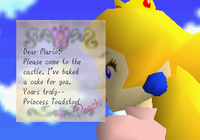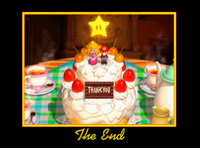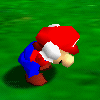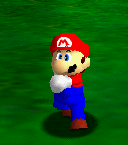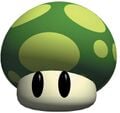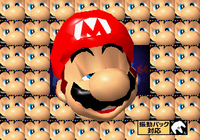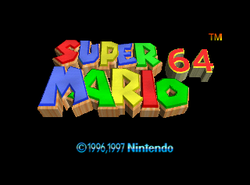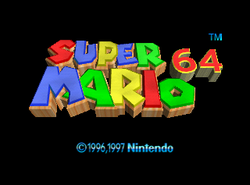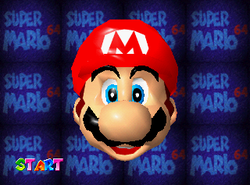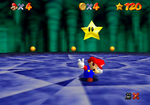Super Mario 64: Difference between revisions
No edit summary |
(wiki doesn't cover fan mods) |
||
| Line 322: | Line 322: | ||
*''[[Super Smash Bros. for Nintendo 3DS / Wii U]]'' - A cover version of the main theme of ''Super Mario 64'' appears in the DLC stage Peach's Castle (64), which itself is the ''Super Smash Bros.'' stage based on ''Super Mario 64''. | *''[[Super Smash Bros. for Nintendo 3DS / Wii U]]'' - A cover version of the main theme of ''Super Mario 64'' appears in the DLC stage Peach's Castle (64), which itself is the ''Super Smash Bros.'' stage based on ''Super Mario 64''. | ||
==Media== | ==Media== | ||
{{Main|List of media from Super Mario 64}} | {{Main|List of media from Super Mario 64}} | ||
Revision as of 11:47, December 20, 2015
Template:Infobox Super Mario 64 is a 3D action-adventure platformer game released for the Nintendo 64 in 1996. This game was one of two (three in Japan) launch titles for the Nintendo 64, along with Pilotwings 64, which helped drive initial sales of the console. To this day, it has sold nearly over 11 million copies, and is marked as the best selling Nintendo 64 game of all time. It is also the second most popular game on the Wii's Virtual Console, after Super Mario Bros.
Being the first 3D Mario game, Super Mario 64 introduced many moves that would be used in almost every later Super Mario title: Triple Jumping, Ground Pounding, Long Jumping, Crouching, and Somersaults. Punching and kicking were also introduced, but would not be used in any later main title (besides its DS remake).
Super Mario 64 was originally in development for the Super Famicom/SNES, but was moved to the Nintendo 64 after system limitations and the 16-bit era began closing[1], not to mention a lack of proper controls (as the game defined the design of the N64 controller[2]). Though it was not the first 3D platforming game, it revolutionized the genre, with many games soon following its formula using it as a sort of benchmark[3]. It is widely acclaimed as one of the greatest and most important games of all time[4][5][6].
In 2004, a remake of Super Mario 64 was released for the Nintendo DS entitled Super Mario 64 DS. The remake had various differences from the original game such as Luigi, Yoshi, and Wario becoming playable characters. There was also a sequel called Super Mario 64 2 planned for the Nintendo 64DD, but it was cancelled due to the 64DD's commercial failure. The game was rereleased digitally on the Wii U's Virtual Console service on April 1st 2015, making it and Donkey Kong 64 the first two Nintendo 64 games to be released on the service.
Storyline
Princess Toadstool (or "Peach", as she is called for the second time in the western world since Yoshi's Safari introduced it) sent a letter to Mario to come and have some cake with her in the castle. When Mario arrives, he finds one of the Lakitu Bros. who follows him around holding a camera and filming him. Together, they go inside and hear a familiar voice telling them to get out of the castle, actually being Bowser. Toad informs them that Bowser has kidnapped Peach again and is holding everyone hostage inside the castle walls. He has also stolen the 120 Power Stars and given them to his minions who are hiding in the paintings that are accessible from inside the castle. Mario must jump into each painting scattered around the castle in order to retrieve the power stars.
Toad informs Mario about a Bob-omb field where King Bob-omb must be faced. The first of many power stars can be found here. By obtaining more Power Stars, Mario unlocks doors to three more paintings in the castle including the Whomp's Fortress, Jolly Roger Bay, Cool, Cool Mountain, and the ability to collect more stars.
When Mario collects eight Power Stars, he can open the Star Door at the left side of the castle. He then falls through the floor in the room and enters the first Bowser Course, Bowser in the Dark World. After traveling through the course, he enters a warp pipe, which leads him to Bowser. After evading Bowser's attacks and grabbing his tail, Mario throws him into a bomb on the edge of the stage defeating him. Unfortunately, it turns out that Bowser doesn't have Peach with him. Instead, he floats into the air and disappears, leaving a key for Mario to collect. Mario then obtains the key that allows him to enter the basement of the castle. The basement contains four levels, which are Lethal Lava Land, Shifting Sand Land, Hazy Maze Cave, and Dire, Dire Docks. After collecting 30 stars, Mario is granted with the ability to open another star door in the basement. The Star Door leads to a room with the entrance to Dire, Dire Docks and the second Bowser course, Bowser in the Fire Sea. After navigating through the course, Mario jumps into another battle with Bowser. This battle can be more challenging than the last one, since Bowser can now teleport and tilt the stage. Also, the distance between the arena platform and the bombs has increased. When Mario defeats Bowser for the second time, Mario gains a key to the second floor leading to even more paintings. After Mario collects his 50th Power Star, he can go up to the third floor, and once Mario collects 70 Power Stars, he can access the door into Bowser's final stage, Bowser in the Sky, and go through another one of his obstacle courses. After he finds the warp pipe at the end of the course, Mario finds Bowser waiting for him. The two then begin to engage in battle. This time, Bowser has to be blown up by a bomb three times. When Bowser gets blown up twice, certain parts of the arena fall away, leaving the platform in a shape of giant star. Bowser ends up defeated, and is surprised when Mario tells him there were some Power Stars he missed; the Castle's Secret Stars. Bowser gives up, and hands Mario the final Grand Power Star before he disappears. When Mario grabs the last power star, wings appear on his cap, allowing him to fly. He circles the star-shaped arena, and flies away. Eventually, he lands in front of the castle.
As his wings fade away, Mario uses the power of the Giant Power Star to save Peach and take her back at the front of the castle. The star goes into the stained glass window over the front door of the castle, the window flashes, and Peach slowly descends to the ground. Mario rushes up to her as she opens her eyes. Thanking him, Peach kisses Mario on the nose and says she will bake a cake for him. Peach and two nearby Mushroom Retainers walk into the castle. Mario starts to do so himself, but then pauses and turns around to look at the upward. Peach calls him, and he rushes after her. After the credits roll, Mario, Peach and two Toads wave goodbye to the player, followed by the cake, with Peach and Mario figures, shown at the very end. The game will then freeze, and the console will have to be turned off or restarted. (This was customary for beating the final Boss at the time, since "extra mode" was not a popular concept.)
Courses
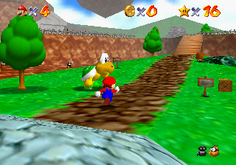
Levels are laid out inside paintings in the castle, or sometimes the walls themselves. They can also be found in holes, portals, oil pits, and inside a clock. Each world has seven Power Stars. Within each, one of which is gained by finding one hundred coins in the level. The other six Power Stars are found by performing "missions", fighting bosses, winning races, etc. Every course has boundaries to limit the player from going too far, either as a strict wall or an invisible boundary. If Mario hits either, he falls down (quite often losing a life). Otherwise, Mario is free to roam the large expansive levels at his leisure.
Levels often feature pink Bob-ombs called Bob-omb Buddies. They open cannons littered around the levels for Mario to fly with. When the cannon is open, Mario simply falls into the pit where it is, and it raises. The player targets the cannon with a cross hair shot, and fires. This helps Mario reach high or far away areas. It is often a good idea to use the Wing Cap (see below) with cannons.
| Bob-omb Battlefield | Whomp's Fortress | Jolly Roger Bay | |||
|---|---|---|---|---|---|
| Big Bob-omb on the Summit | Footrace with Koopa the Quick | Chip Off Whomp's Block | To the Top of the Fortress | Plunder in the Sunken Ship | Can the Eel Come Out to Play? |
| Shoot to the Island in the Sky | Find the 8 Red Coins | Shoot Into the Wild Blue | Red Coins on the Floating Isle | Treasure in the Ocean Cave | Red Coins on the Ship Afloat |
| Mario Wings to the Sky | Behind Chain Chomp's Gate | Fall Onto the Caged Island | Blast Away the Wall | Blast to the Stone Pillar | Through the Jet Stream |
| Cool, Cool Mountain | Big Boo's Haunt | Hazy Maze Cave | |||
| Slip Slidin' Away | Li'l Penguin Lost | Go on a Ghost Hunt | Ride Big Boo's Merry-Go-Round | Swimming Beast in the Cavern | Elevate for 8 Red Coins |
| Big Penguin Race | Frosty Slide for 8 Red Coins | Secret of the Haunted Books | Seek the 8 Red Coins | Metal-Head Mario Can Move! | Navigating the Toxic Maze |
| Snowman's Lost His Head | Wall Kicks Will Work | Big Boo's Balcony | Eye to Eye in the Secret Room | A-Maze-ing Emergency Exit | Watch for Rolling Rocks |
| Lethal Lava Land | Shifting Sand Land | Dire, Dire Docks | |||
| Boil The Big Bully | Bully The Bullies | In the Talons of the Big Bird | Shining Atop the Pyramid | Board Bowser's Sub | Chests In The Current |
| 8-Coin Puzzle With 15 Pieces | Red-Hot Log Rolling | Inside the Ancient Pyramid | Stand Tall On the Four Pillars | Pole-Jumping For Red Coins | Through The Jet Stream |
| Hot-Foot It Into the Volcano | Elevator Tour In The Volcano | Free-Flying For 8 Red Coins | Pyramid Puzzle | The Manta Ray's Reward | Collect the Caps... |
| Snowman's Land | Wet-Dry World | Tall, Tall Mountain | |||
| Snowman's Big Head | Chill with the Bully | Shocking Arrow Lifts | Top o' the Town | Scale the Mountain | Mystery of the Monkey Cage |
| In the Deep Freeze | Whirl From the Freezing Pond | Secrets in the Shallows and Sky | Express Elevator--Hurry Up! | Scary 'Shrooms, Red Coins | Mysterious Mountainside |
| Shell Shredding for Red Coins | Into the Igloo | Go to Town for Red Coins | Quick Race Through Downtown! | Breathtaking View from Bridge | Blast to the Lonely Mushroom |
| Tiny-Huge Island | Tick Tock Clock | Rainbow Ride | |||
| Pluck the Piranha Flower | The Tip Top of the Huge Island | Roll into the Cage | The Pit and the Pendulums | Cruiser Crossing the Rainbow | The Big House in the Sky |
| Rematch with Koopa the Quick | Five Itty Bitty Secrets | Get a Hand | Stomp on the Thwomp | Coins Amassed in a Maze | Swingin' in the Breeze |
| Wiggler's Red Coins | Make Wiggler Squirm | Timed Jumps on Moving Bars | Stop Time for Red Coins | Tricky Triangles | Somewhere Over the Rainbow |
Secret Stars
In addition to the main courses of the game and the Bowser Courses, there are also a few hidden courses that house several of the Castle's Secret Stars, as well as the three ! Switches.
- The Princess's Secret Slide (2 Stars)
- The Secret Aquarium (1 Star)
- Tower of the Wing Cap (Wing Cap) (1 Star)
- Vanish Cap Under the Moat (Vanish Cap) (1 Star)
- Cavern of the Metal Cap (Metal Cap) (1 Star)
- Bowser in the Dark World (1 Star)
- Wing Mario Over the Rainbow (1 Star)
- MIPS the Rabbit (2 Stars)
- Toad's Secured Stars (3 Stars)
- Bowser in the Fire Sea (1 Star)
- Bowser in the Sky (1 Star)
Enemies
New Enemies
Returning Enemies
Abilities
In addition to Mario's signature jumping, a whole new host of abilities is given to the player. Mario can punch, kick, kick jump, hip drop (Ground Pound, something Yoshi and Wario could do in previous games), triple jump, long jump, back flip, somersault, and perform the wall kick (bouncing from wall to wall with timed jumps to reach higher areas). The usual Super Mushroom and Fire Flower are absent in this game. Instead as the game progress, Mario gains the power to wear new hats, in the form of colored Caps, with multiple abilities exclusive to each. The Power Gauge is also introduced in a circular form which became standard for future three dimensional "Mario" games, (though it made an appearance beforehand, in a vertical form, in Super Mario Bros. 2).
The Caps are found inside special '!' blocks littered around the every level. Initially empty, they can be filled by finding '!' switches (similar to the Switch Palaces of Super Mario World). There are three colors to the caps, and each cap lets Mario perform different abilities. Only one (or occasionally two) forms of colored caps are in each level. Normally, each cap is worn separately, but Mario can sometimes don two caps at once and combine the abilities of both.
- The Wing Cap (red) allows Mario to transform into Wing Mario and fly around if he performs a triple jump or blasts out of a cannon. This is useful for reaching high or far areas, and finding secrets in the sky. Also, the Wing Cap lets Mario do a Triple Jump without having to walk/run.
- The Vanish Cap (blue) makes Mario transform into Vanish Mario which makes him invulnerable to attacks. He can also walk through some walls to reach new areas, where he can find hidden items or Power Stars. Also, all enemies' attacks travel through him.
- The Metal Cap (green) causes Mario to transform into Metal Mario, which makes him metallic and heavy. This lets Mario defeat enemies by walking into them, walk through streams of fire without taking damage, avoid water currents, and walk under water. Because of his weight, all Mario can do in this form is walk and jump.
Bosses
There are various mini bosses in some stages, but the primary boss is Bowser. He appears three times in three different levels. This is a list of the bosses in the game.
- King Bob-omb - A giant Bob-omb in Bob-omb Battlefield. He appears as the first boss in the game, and the first star.
- Whomp King - A giant Whomp on top of Whomp's Fortress. He appears as the first star, and after he is defeated, there is a tower on top of the fortress.
- Bowser in the Dark World - Bowser appears at the end of this level. The player needs to swing him by the tail clockwise or counterclockwise and hurl him at bombs on the outside of his circular arena.
- Big Bully - Two of these giant Bullies appear in Lethal Lava Land. On both occasions they try to knock Mario into the lava.
- Eyerok - Two stone hands with eyes on their palms. They appear when the player blasts open the top of the Pyramid in Shifting Sand Land and ride the elevator inside.
- Big Boo - A giant Boo which appears three times in Big Boo's Haunt. He initially appears once all the Boos in the mansion have been removed, again in the underground Merry-Go-Round, and lastly on the top balcony of the mansion (possibly what inspired Boolossus).
- Big Mr. I - A giant Mr I which only appears in the attic of Big Boo's Haunt.
- Bowser in the Fire Sea - Bowser appears at the end of the level. Game play is the same as the first Bowser, except now his jumps make the arena tilt, causing Mario to need to run up the arena to avoid falling off. Bowser also gains a new move where he vanishes and reappears a short distance away.
- Chill Bully - A large Bully made of ice. He tries to ram Mario onto a lethally frozen pond in Snowman's Land.
- Wiggler - A giant Wiggler, which becomes angry when his home in Tiny-Huge Island gets flooded.
- Bowser in the Sky - Bowser appears at the end of this level. He must be thrown into the bombs three times. Each time he falls off the arena, his jump back makes a piece of the arena fall off. After being hit twice, he stomps the ground and more of the arena will fall off, which then the remaining section of the arena becomes star shaped. Once Bowser gets hit the third time, he will be defeated, leaving behind a Giant Star, which is not added to the Power Star total after it is collected. The game will then be completed.
Notable mistakes and errors
- When speaking to Yoshi on the castle roof, Yoshi says "Mario!!! It that really you???" instead of "Mario!!! Is that really you???".
- If Mario is one star short of opening a door, it will still refer to the word needed in the plural: "You need 1 more stars" instead of "You need 1 more star."
Those errors remained in the Virtual Console version. However, they were fixed in the remake, as Yoshi is a playable character, and the message that appears when Mario doesn't have enough stars to open a door is "You need 1 more."
References to other games
- Super Mario Bros. - A carving of Mario from this game appears on a pillar in Bowser in the Sky. There is also a small jingle used at the Power Star select screen which sounds identical to the first few notes of the opening theme in this game.
- Super Mario World - The idea of Switch Palaces is in a way brought back. Also, when Yoshi is met, he says to Mario "It has been so long since our last adventure!", referring to this game. Also, the soundtrack follows the same composition technique used in Super Mario World in a similar way where there's a signature melody in the game that's heard across different levels in several variations (Bob-omb Battlefield, Snow Mountain, Slider).
- Super Mario World 2: Yoshi's Island - The theme used for invincibility in this game, specifically the string instruments playing in the background, is reworked into Wing/Vanish Mario's theme for Super Mario 64. The idea of collecting red coins first appeared in this title as well.
References in later games
- Donkey Kong Country 3: Dixie Kong's Double Trouble! - Wrinkly Kong plays this game sometimes in her Save Caves. The theme of Wrinkly's Save Cave is also very similar to the song Inside the Castle Walls.
- Mario Kart 64 - Peach's Castle is hidden on Royal Raceway and its appearance is identical to Super Mario 64. The castle grounds are also there and unchanged between the two games. The drawback is the castle is inaccessible. Penguins in Sherbet Land have a identical appearance and a big penguin (most likely Big Penguin) is in the center of the course on an island of ice.
- Super Smash Bros. - Most of Mario's moves, animations and his voice clips in this game are derived from the ones in Super Mario 64. Metal Mario appears as a boss. Two levels based on places here are also accessible, such as Metal Mario's stage and Peach's Castle. Although Luigi didn't appear in the game, his moves and his voice clips are identical to Mario's in Super Mario 64 except Luigi's voice clips are higher-pitched versions of Mario's.
- Paper Mario - This game starts the same way, with a letter being sent from Peach. Peach's Castle returns and the main room is near identical (however the doors do lead to different rooms).
- Mario Kart: Super Circuit - Peach's Castle re-appears in the background of Peach Circuit, Mario Circuit 1 and Mario Circuit 4.
- Super Smash Bros. Melee - Two stages based on areas from Super Mario 64 appear: Princess Peach's Castle (which also appears as a trophy) and Rainbow Ride (which also includes a cover of the Super Mario 64 - Slide music). Metal Mario reappears as a boss and trophy. Additionally, the Metal Box returns in this game as an item and a trophy. Mario still has his voice clips, moves, and animations and Luigi still has Mario-like voice clips, moves, and animations. One of Kirby's Stone form is based on a Thwomp from this game.
- Super Mario Sunshine - A brief clip of Mario's fight with Bowser is seen when F.L.U.D.D. scans Mario.
- Mario & Luigi: Superstar Saga - In Woohoo Hooniversity, a room with four blocks can be seen in it. One of them is a block from Super Mario 64. The name of the game is even mentioned in the description of the blocks, and the professors are trying to figure out why it vanishes when struck.
- Paper Mario: The Thousand-Year Door - The game starts in the same way, Peach sends Mario another letter.
- Mario Power Tennis - The music that plays in the minigame, Artist On the Court has the Peach Castle theme covered.
- Super Mario 64 DS - This game is a remake of Super Mario 64. Also, at the start, Yoshi is on the roof and jumps down, a reference to the fact that he is there at the end of Super Mario 64.
- Mario Kart DS - Tick Tock Clock appears as a race track in this game. Several bosses found here also reappear in this game.
- Mario & Luigi: Partners in Time - The theme that plays in Peach's Castle is a cover version of this game's castle theme. Also, ! Blocks appear in this game.
- New Super Mario Bros. - This game uses many things found here, such as Dorrie, and a Bowser head closes in on the screen when the player dies. Also, Wing/Vanish Cap theme is present for Invincibility.
- Mario Strikers Charged - A cover of the music that plays in Big Boo's Merry-Go-Round is featured in this game, as the theme associated with Boo sidekicks.
- Super Mario Galaxy - The game starts in the same way, with Peach sending Mario another letter. Also, the Bowser's Road theme is covered for Bowser's Star Reactor. Also, the falling asleep idle animation returns.
- Super Smash Bros. Brawl - Music from Bob-omb Battlefield is unlockable, and the Rainbow Ride stage/music and Metal Box from the previous game returns as well.
- Mario Super Sluggers - Both songs that play when playing in Peach's Ice Garden and going into said place in Challenge mode are remixes of the castle theme from this game.
- Mario & Luigi: Bowser's Inside Story - The music for when the Mario Bros first enter Peach's Castle and when everyone is removed from Bowser's Belly is a cover of the Peach's Castle theme. Also, both games end in a view of a cake with Mario and Peach figures on it.
- Mario & Sonic at the Olympic Winter Games - The Cool, Cool Mountain and Snowman's Land course music is covered for the Dream Snowball Fight event in this game. The main theme and the Bowser's stage theme is also used.
- New Super Mario Bros. Wii - The trademark Peach's Castle music reappears in the game.
- Super Mario Galaxy 2 - In both Tall Trunk Galaxy and Rolling Coaster Galaxy, The Princess's Secret Slide music plays at a moment. Also, the Whomp's Fortress reappears as the Throwback Galaxy, alongside Bob-omb Buddies and the Whomp King. Both games start with Peach sending a letter to Mario. Also, the orchestral cover of Bowser's Road theme can be heard in Bowser's Lava Lair and Bowser's Gravity Gauntlet.
- Super Mario 3D Land - The sound effect of Mario falling from heights is reused, plus the platforming style is mixed together with Super Mario Bros 3 and Super Mario Galaxy. Also, when the player waits outside a purple Mystery Box on the map screen, the endless stairs music from Super Mario 64 can be heard.
- Mario Kart 7 - Metal Mario appears as a playable character.
- Mario Tennis Open - A cover of Peach's Castle is used in Peach's Palace. In the Bowser's Castle court, a cover of the Bowser battle music is played.
- New Super Mario Bros. 2 - The first few notes of the Peach's Castle theme are played during the intro.
- Paper Mario: Sticker Star - The Princess's Secret Slide music is covered during the Minecart part of Bowser's Snow Fortress.
- New Super Mario Bros. U - The castle moat appears in the game but it is inaccessible due to it only appearing on the world map and, when Peach's Castle is entered, the moat is seen as lava.
- Super Mario 3D World - A cover of The Princess's Secret Slide music plays when riding Plessie. In Shifty Boo Mansion, a level in Super Mario 3D World, there is a Green Star hidden behind a portrait of a Boo that can be entered like the pictures in Princess Peach's Castle.
- Mario Party: Island Tour - A cover of Koopa's Road plays in Bowser's Peculiar Peak.
- Mario Kart 8 - Princess Peach's Castle reappears in the retro course Royal Raceway.
- Super Smash Bros. for Nintendo 3DS / Wii U - A cover version of the main theme of Super Mario 64 appears in the DLC stage Peach's Castle (64), which itself is the Super Smash Bros. stage based on Super Mario 64.
Media
- Main article: List of media from Super Mario 64
Reissues
- Main article: Super Mario 64 DS
Super Mario 64 DS is the remake of the game for the Nintendo DS, bearing some new features on its storyline, gameplay and graphics. Unlike Super Mario 64, Mario is not the only playable character (nor is he even available at the start, the only character available at the start of the game is Yoshi); Yoshi, Luigi, and Wario also join the adventure in order to rescue Princess Toadstool from the hands of Bowser. Other new features within the game include a multi-player mode, in which up to four players can play simultaneously on each Nintendo DS connected together locally; minigames to play with each character, and new additions to the story mode such as new missions and levels.
A version of the original game was released in Japan on July 18, 1997, that included Rumble Pak support. This game is the same as the International release of the game, as it retains all of the glitch fixes as well as graphical and sound changes (except Mario calling Bowser by his name in the "So long-eh Bowser" voice clip, which was changed to "buh-bye"). The only differences other than one voice clip are the language being changed back to Japanese, a new title screen easter egg, fixing of the "backwards long jump" glitch and the Rumble Pak support.
Official soundtrack
- Main article: Super Mario 64 Original Soundtrack
An original soundtrack that is based on the game is released. It has thirty-six tracks from the game.
Gallery
- Bowsersm64.gif
Bowser
- Sm64 the big boo.png
Boo
- Powerstar64.png
Power Star
Regional differences
There is a total of four releases of this N64 game Super Mario 64: The original NTSC-J Japanese version, the European and the Australian PAL release, the American NTSC-U release, and the Shindō Pak Taiō (Shindou Edition) NTSC-J re-release in Japan. The Shindou Edition includes almost all the changes from the original Japanese version to the American version, plus the Backwards long jump glitch was fixed. It was also the version used for the Japanese Wii U Virtual Console release.
The PAL version is limited to 25 FPS as opposite to 30 FPS of the NTSC releases, therefore Mario movements are much slower in the PAL version. Also the PAL version allows the player to change the language between "English", "German" and "French" (the third doesn't work in the Australian versionTemplate:Refneeded) in the options menu in addition to the ability to change sound options. The NTSC releases remove the language selection (instead locking it into either English or Japanese) and, since only sound options are left, changes the menu's name from "Options" to "Sound".
Gameplay changes
The Shindou Edition re-release adds Rumble Pak support which was not supported by older releases. The Intro Screen add a little box to inform the player about this feature. Also, a new Easter Egg was added in this version, at the "Press Start" screen, if the player presses ![]() , the background will be filled with images of Mario's face. This is taken from the frame buffer, so the faces move alongside the modeled Mario face.
, the background will be filled with images of Mario's face. This is taken from the frame buffer, so the faces move alongside the modeled Mario face.
In the original Japanese version, after defeating Bowser, the key collection cutscene shows a Star instead of a key; early footage of the first Bowser fight shows him leaving behind a Star upon defeat, suggesting that this is a very old leftover.
Several glitches which were present in the Japanese version have been fixed for the American release:
- When the player steps on one of the Cap's switches, the surroundings stop moving until the text is advanced, however if the player collects the star before the text appears, the star would not disappear upon collection. In the American release, the surroundings don't stop moving anymore.
- It's possible to collect more than 999 coins (for instance, grabbing the coins generated by Bowser's fire), at which point in all other releases the coin counter gets forced back to 999. However, due to an overlooked mistake in the Japanese code, it tries to set the life counter instead to 999. Since the life counter is only 8 bits, this becomes -25, which is displayed as M25 in the game. (M is used in the place of a minus sign.)
- After Bowser is defeated the first of the second time, he leaves behind the key, if the player runs to where the key will land and press
 and look somewhere, Mario will keep looking that way during the key collection cutscene, this glitch was fixed in all other releases.
and look somewhere, Mario will keep looking that way during the key collection cutscene, this glitch was fixed in all other releases. - A glitch exists in Shifting Sand Land causes the audio to stop playing and possibly freeze the game. The glitch was fixed in other releases.
- In the Japanese version, if Mario exits a level while standing on a falling bridge block, when he returns to the castle he will clip through the first thing he stands on. This was also fixed in later releases.
Level design changes
In Jolly Roger Bay the fifth star: Blast to the Stone Pillar, in the original Japanese version, the Power Star was in the open, however in the international releases, the star was put in an Exclamation Mark Block possibly to make the star's location not too obvious. Nonetheless, the star is out in the open again in the DS remake.
In Cool, Cool Mountain the second star: Li'l Penguin Lost, in the original Japanese version, after returning the baby penguin, the star appears right above the mother; the star was a tad hard to collect due to the large size of the penguin, so other releases moved the star a little away from the mother.
Graphical and textual changes
A few differences are found in the title screen between versions.
The intro screen says "PRESS START" in the NTSC versions, but just "START" in the PAL version. The text location was also moved slightly to the left in the PAL version.
The unused "key" HUD icon was removed from the non-Japanese versions. It appears as a garbled mess in the US version, and as a silver-blue Ü in the European version.
In the European version, the "German Umlauts" (Ä, Ö and Ü) were added. However the Ü isn't used anywhere in the game. The Japanese versions have all the English alphabetical characters (except X, there is a similar "×" that is used in the HUD), the J,Q,V,Z were dropped in the American release and replaced with messed garbage texture, the V and Z were re-added in the PAL release of Super Mario 64. The Japanese versions also has exclusive Japanese characters which were removed in other releases.Template:Refneeded Also in non-Japanese versions, the "%", "&", "!", and "!!" were removed, oddly enough those textures are not used anywhere in the game except in the debug screens.
The Jolly Roger Bay' painting in the original Japanese version is essentially water with some bubbles added in. It also was unique in that it did not have a gold frame (supported by almost every other painting in the game, excluding the Wet-Dry World painting). In all other versions, the painting has been changed and the frame was made golden.
Audio changes
- The Chain Chomp makes a totally different barking sound in the original Japanese version.
- The Red Coins use a different sound that doesn't increase in pitch for each collected coin in the original Japanese version.
- Certain sound effects are missing in the original Japanese game's opening, specifically the "whoosh" when Lakitu is flying, the "click" when the camera goes into his point of view, and the "boing" when Mario jumps out of the pipe.
- The warping sound effect heard when exiting a course without getting a Star is absent in the Japanese version, and the star sound effect doesn't play when entering certain "mini-courses" like the Tower of the Wing Cap.
- An audio cue titled "Lakitu's Message" was added when Lakitu flies up to Mario to introduce himself and explain the camera controls. Thus, it isn't in the official soundtrack.
- In the intro, when Mario jumps out of the pipe and the pipe goes back into the ground, a variation of the classic Mario "pipe sound" is heard in the US version. This sound has been made a lot quieter in the PAL version, almost down to where the player can't hear it.
- In the PAL version, the Star Door closing sound is very similar to the opening sound, this is not the case in all other versions.
- The yellow coin collecting sound is slightly slowed down in the PAL version.
- When letting go of Mario's face when playing around with it, the PAL version's sound is off.
- Mario's Double Jump sound is different in the PAL version; which was later used for the Shindou Edition (albeit higher-pitched).
- One of Mario's first Jump sounds is higher-pitched in the Shindou Edition.
- In the original Japanese version, Mario says "Here we go!" no matter how far he swings Bowser. In the international version, he only says "Here we go!" when swinging Bowser a short distance away; when Mario swings Bowser far away he says "So long-eh Bowser!". In the Shindou version, he says "Here we go!" when swinging Bowser a short distance away but for a long distance he says "Buh-bye!" as Bowser is normally called Koopa in Japan. The Shindou quotes are used for Super Mario 64 DS.
- Mario doesn't say a few lines in the original Japanese version:
- "Hello!" when Mario's face greets the player.
- "Okey-dokey!" when the player chooses a save file.
- "Let's-a go!" when the player chooses a star.
- "Game over!" when the player runs out of lives.
- "Press START to play!" when the player is watching the demo.
- "D'oh!" when the player Long Jumps or dives into a wall. He instead says "Uhn!" like when he otherwise hits a wall.
- "Boing!" when the player jumps off a Spindrift.
- "Wha-ha!" or "Yipee!" when the player Triple Jumps. He instead only says "Yahoo!" which can also randomly happen in international versions.
- "Ha ha!" when leaping out of the pipe in the intro. He still says it after a backflip.
- Mario doesn't say "Mamma mia!" when falling out of a non-painting course after the player loses a life in the Japanese version. He does in the international versions.
- His "I'm-a tired!" and dreams about pasta while sleeping.
- Princess Peach doesn't have any voice acting in the original Japanese release during the beginning and final cutscenes. This was added for all other versions.
Pre-release and unused content
- Main article: List of Super Mario 64 pre-release and unused content
The most notable unused content is the Blargg, which is still in the game's data, that would appear in the Lethal Lava Land, Bowser in the Fire Sea, And Wing Mario over the Rainbow stages. Also, Big Boo held a key instead of a Star inside of him. The purpose of the keys was to unlock a variety of the various doors in Big Boo's Haunt - there was even a "key counter". 32 levels were planned for the game, but only fifteen of them made it into the final product.
Reception
Super Mario 64 received critical acclaim, garnering a score of 9.8 from IGN, 9.4 from GameSpot, and 9.75 from Game Informer. Although it was criticized for its camera system and difficulty, it was praised for its graphics, level design, soundtrack, and the Mario series shift from 2D to 3D.
Sometime after the game's release, rumors about secret glitches, stars, and hidden characters circulated. Among the most famous is the widely publicized hoax that Luigi was hidden and fully playable, causing bogus rumors to circulate on how to unlock him.
Super Mario 64 is the best selling game for the Nintendo 64, selling 11.62 million copies worldwide, as of December 31, 2009.
Glitches
- Main article: List of glitches in Super Mario 64
The most famous glitch is probably the Template:Conjecturaltext which will let the player climb any stairs including the Endless Stairs. Another famous glitch is the Template:Conjecturaltext which is Mario being trapped in the castle walls. It could be achieved using several ways, including using the Backwards Long Jump glitch. Another rather known glitch is the cloning glitch, often used to collect more coins than the actual number of coins in the game.
As in many other N64 titles, the cartridge can be tilted in the console to achieve messed up results, for example Mario's body will flip horizontally, but he can still be controlled. Also, the music will be heavily corrupted.
Several glitches exists in the Japanese In multiple areas of the game, there are unintended invisible walls that the player can bump into. The most popular one is probably the one in Tall, Tall Mountain just above the wooden log.
The top of the castle is normally only accessible using the cannon that can be unlocked after gathering 120 Power Stars, however version, however they were fixed in the other releases. While collecting one of Bowser's keys, the player can press ![]() , and looks somewhere, Mario will keep looking that way during the key collection cutscene.
, and looks somewhere, Mario will keep looking that way during the key collection cutscene.
Using a good timed Triple Jump on the slope near the castle, the player can climb the castle without the cannon. Also, when Mario reaches a corner, he can fall down slightly and grab onto a ledge. The player can then pull themselves back up onto the roof, at which point Mario will lose a life. For unknown reasons, he also loses his hat.
When the player is going to exit the endless stairs with less than seventy stars, the saying Bowser states about the required number of stars to solve the endless stairs will show and then the player exits the path to the endless stairs. In the remake, the glitch is fixed.
Template:Conjecturaltext
When Mario enters the water, the angle Mario was facing before entering is preserved in a datum, therefore, when the player jumps and lands on dry land, the next dive Mario performs will start with this angle. A few frames afterward, the angle will fix itself and the dive will be completed correctly. Several things "reset" the angle, including grabbing a ledge, shooting from a cannon, changing areas and jumping while facing a slope. This glitch does not affect the dive itself, just the animation.
Staff
- Main article: List of Super Mario 64 staff
Game director
- Shigeru Miyamoto
Assistant directors
- Yoshiaki Koizumi
- Takashi Tezuka
Mario face programmer
- Giles Goddard
Course designers
- Kenta Usui
- Naoki Mori
- Yoshiki Haruhana
- Makoto Miyanaga
- Katsuhiko Kanno
Names in other languages
Trivia
- Boo's laugh is actually Bowser's laugh sped up.
- If a second controller is plugged into the N64, it can be used to control the camera while Peach congratulates Mario during the credits.
- Super Mario 64 was one of the games featured at The Art of Video Games exhibition at the Smithsonian American Art Museum in 2012.[7] The game won voting in the "action" category for the Nintendo 64, beating out Banjo-Kazooie and Star Wars: Shadows of the Empire.
- Like most Nintendo 64 games at the time, Super Mario 64 does not use the full 64-bit capabilities of the console, but actually runs in 32-bit.
- Along with Mario Kart 64, this game marks the first time Mario, Peach, Bowser, and Toad receive a revamped appearance from the original hand-drawn era to the N64 3-D art direction of the Mario franchise.
- The music which plays while climbing the endless staircase is a Shepard tone, a sequence of notes which are made to sound as if they are infinitely ascending in tone when in fact they are looping.
References
- ^ N-Sider.com: Profile - Shigeru Miyamoto
- ^ http://www.youtube.com/watch?v=glC3zXaJjtQ
- ^ GameSpot - 15 Most Influential Games of All Time
- ^ GameFaqs - The top 10 games Ever
- ^ Edge Online - The 100 Best Games to Play Today
- ^ Official Nintendo Magazine - 100 Best Nintendo Games
- ^ http://americanart.si.edu/exhibitions/archive/2012/games/#games
External links
| Nintendo 64 games | |
|---|---|
| Super Mario franchise | Super Mario 64 (1996) • Mario Kart 64 (1996) • Mario no Photopi (1998) • Mario Party (1998) • Mario Golf (1999) • Mario Artist: Paint Studio* (1999) • Mario Party 2 (1999) • Mario Artist: Talent Studio* (2000) • Mario Artist: Communication Kit* (2000) • Mario Tennis (2000) • Paper Mario (2000) • Mario Artist: Polygon Studio* (2000) • Mario Party 3 (2000) • Dr. Mario 64 (2001) |
| Donkey Kong franchise | Diddy Kong Racing (1997) • Donkey Kong 64 (1999) |
| Yoshi franchise | Yoshi's Story (1997) |
| Crossovers | Super Smash Bros. (1999) |
